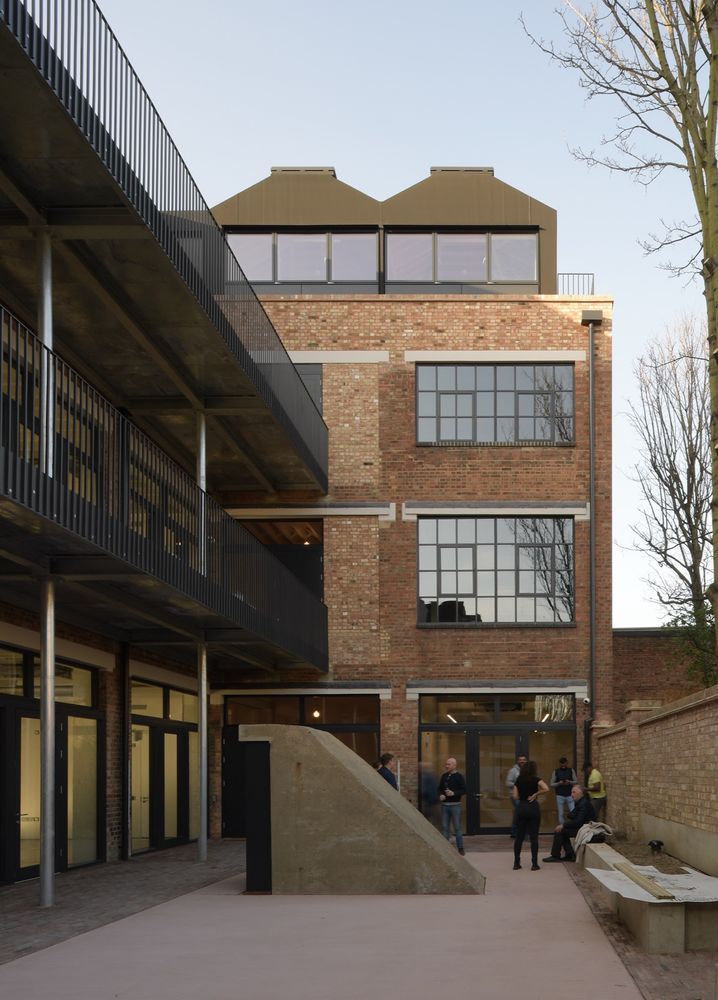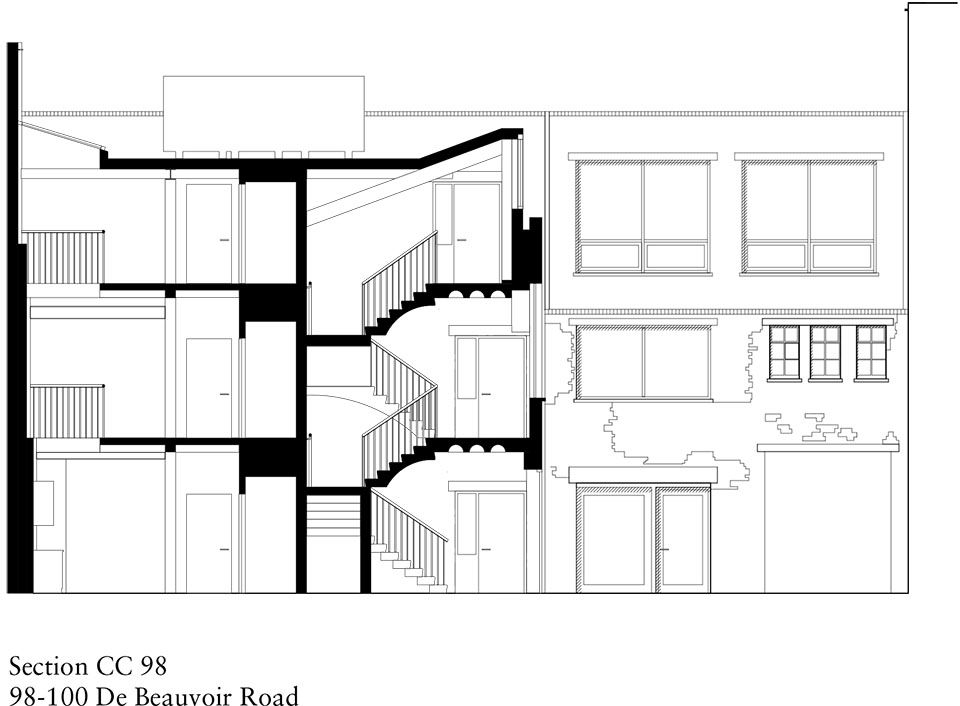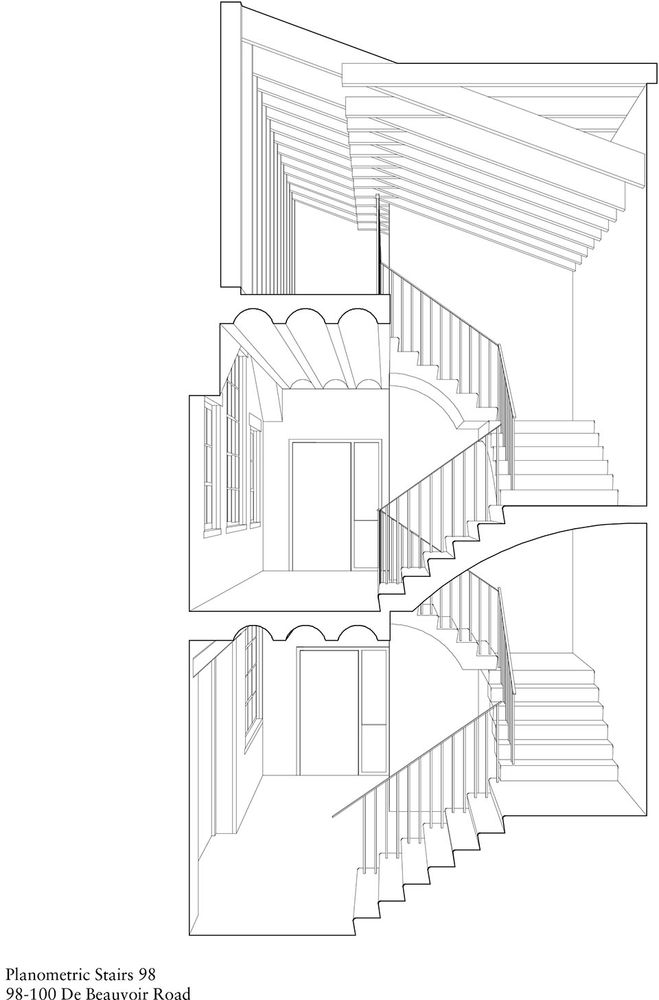De Beauvoir路98-100号建筑改造,伦敦 / Henley Halebrown
De Beauvoir路98-100号的改造延续了事务所对一系列现有历史建筑的适应性再利用,包括Talkback、E.W. Pugin’s St. Monica’s、Hoxton以及最近的De Beauvoir街区、Laszlo和Poppy工厂等项目。
98–100 De Beauvoir Road continues the practice’s work in the adaptive reuse of existing and historic structures such as Talkback, E.W. Pugin’s St. Monica’s, Hoxton and the more recent schemes De Beauvoir Block, Laszlo and the Poppy Factory.
▼从街角看向建筑群,building block viewing from street © Nick Kane

98-100号是一系列二十世纪早期工业建筑的一部分,位于De Beauvoir镇De Beauvoir广场以西,紧邻一批新雅各宾风格的历史保护建筑。该镇是伦敦的一个地区,规划于19世纪20年代,即大联盟运河将金斯兰盆地切断的时期。
98–100 forms part of a range of early Twentieth Century industrial buildings immediately west of De Beauvoir Square, and its listed Neo-Jacobean houses, in De Beauvoir Town, an area of London planned after the Grand Union Canal and Kingsland Basin were cut in the 1820s.
▼改造项目概览,overview of the renovation © Nick Kane

De Beauvoir镇的工作空间有限,需求量很大。这些日照充足、自然通风的建筑计划逐层、逐栋出租,或者(根据目前的情况)作为一个园区出租给单个住户。每栋楼都有新的楼梯、电梯和卫生间。这种低碳改造方案保留了砖砌结构、木材、铸铁和现浇混凝土框架中的大部分结构和能量。我们采用基于手工业的低技建造方法,让办公室的建造回归原始。与原有结构一样,一切都非常坚固耐用,几乎无需维护。
Workspace within De Beauvoir Town is limited so demand is high. These daylit, and naturally ventilated buildings have been planned to be let floor-by-floor, building by building or (as it has transpired) as a campus for a single occupant. Each building has a new staircase, lift and WC core. This low carbon retrofit scheme retains much of the fabric and embodied energy in the brickwork, timber, cast iron and insitu concrete frame. And the craft-based low-tech building techniques employed indicate how elementary the construction of an office might be. Like the original fabric, everything is robust so it may endure with little maintenance.
▼街道入口,street entrance © Nick Kane

▼小庭院,the small courtyard © Nick Kane

直到最近,这些建筑平静的砖砌立面仍掩盖着一个多世纪以来不断增添和改建的混杂空间。我们的方案重塑了空间,并重新规划了内外部流线,创作了一个小型的工作室空间园区。设计了一对安静的庭院,庭院两侧的墙壁由粉红色的正宗弗莱顿砖砌成,地面铺设了粉红色的磨砂混凝土。
Until recently the buildings’ calm brick façades concealed a morass of spaces, the result of more than a century of accretions and alterations. Our scheme reshapes space and rewires circulation both inside and out to create a small campus of studio workspaces. The design establishes a pair of quiet courtyards lined by walls of original pink fletton brickwork, and floors laid with a matt of brushed pink concrete.
▼较大的后院,the larger backyard © Nick Kane

每栋建筑都有一个新的楼梯。98号楼的楼梯是”建造 “在新砖木结构中的混凝土。在保留的立面后面,新的楼梯、电梯、厨房和卫生间为修复后的前楼和后楼提供服务。梯段为半拱形,一个连着一个。新的楼梯平台位于原址。在楼梯后面,工作室由一个顶部采光的三层楼体量和各层悬臂式混凝土长廊连接起来,其上方一个木制轻骨架,将这些空间包围起来。
Each building has a new staircase. The one in 98 is concrete and ‘constructed’ within a new brick and timber structure. Behind a retained façade the new stair, lift, kitchens and WCs serve the restored front and rear buildings. Flights are cast as half-arches, bearing one upon another. New landings are in-situ. Behind the staircase, the studios are linked by a top-lit 3-storey volume and, at each level, a cantilevered concrete gallery, with, overhead, a balloon frame of timber, enclosing these spaces.
▼98号的楼梯间改造,stairwell renovation in 98 © Nick Kane

▼半拱形梯段, half-arches flights © Nick Kane

▼通高空间, double-height space © Nick Kane

▼顶部采光结构, top-lit structure © Nick Kane

相比之下,100号中的设计则借鉴了艺术家Gordon Matta-Clark的 “无政府建筑主义”( ‘Anarchitecture’)和早期对环境的关注。设计在原有的木地板上做了一系列切割,悬挂钢制楼梯贯穿其中。每个凸形或凹形开口都被位于曲线切线上的钢梁所剪切。抬头仰望,所有的原始木材都清晰可见,每个楼梯踏板的底部也是如此。淡雅的色调突出了从上方天窗渗透进来的日光效果。
By contrast, the one in ‘100’ takes its cue from the ‘Anarchitecture’ of artist Gordon Matta-Clark and an early concern for the environment. The design makes a series of cuts in the original timber floors. Into these, steel staircases are suspended. Each convex or concave opening is trimmed by a steel beam on the tangent to the curve. Looking up, all the original timbers are visible, as is the underside of each stair tread. Pale hues emphasise the chiaroscuro effect of daylight permeating from the skylight above.
▼悬挂钢制楼梯间, stairwell of suspended steel staircases © Nick Kane


▼楼梯间的景色, scenery in stairwell © Nick Kane

▼室内概览, interior overview © Nick Kane

一个凉廊被设置在在较大的庭院中,并安装了门(取代窗户)和室外楼梯,使得楼层被细分,并且可以在室外工作。
A loggia in the larger courtyard, along with doors (replacing windows) and second stair allows for the floors to be subdivided and occupants to work outside.
▼室外楼梯, outdoor stair © Nick Kane

最后,两座建筑都增加了一层。在98号,一个新的玻璃钢木结构建筑被一个预制白色混凝土凉廊保护起来,以遮挡夕晒。在后部,现有的现浇混凝土结构和钢桁架得到了保留和翻新,玻璃窗的采光和隔热性能也得到了优化。 在 100 号的屋顶上,一个新的结构将一个朝南的狭长庭院和城市景色纳入其中。在内部,环绕庭院的一系列空间都采用了木质结构,而在外部,这些重复的体量则包裹在黑色三元乙丙橡胶(EPDM)中。
Finally, a new storey has been added to both buildings. At 98, a new glazed steel and timber structure is protected from the low sun to the west by a precast white concrete loggia. To the rear, the existing in-situ concrete structure and steel trusses were preserved and refurbished and glazing optimised for daylight and thermal performance. On the roof of 100, a new pavilion frames a narrow court facing south and the city. Inside, the enfilade of spaces around the court are characterised by their expressed timber structure and, outside, these repeating volumes are wrapped in black EPDM rubber.
▼屋顶上加建的结构, new pavilion on the roof © Nick Kane


▼屋顶层内部,interior of new pavilion on the roof © Nick Kane



▼城市景色被纳入框架,city view framed by the pavilion © Nick Kane

▼区位图,site plan © Henley Halebrown

▼首层平面图,ground floor plan © Henley Halebrown

▼二层平面图,first floor plan © Henley Halebrown

▼四层平面图,third floor plan © Henley Halebrown

▼轴测,planometric © Henley Halebrown

▼剖面图,sections © Henley Halebrown


▼98号加建部分轴测,axonometric 98 © Henley Halebrown

▼98号楼梯剖透视,planometric stairs 98 © Henley Halebrown

▼100号楼梯剖轴测,planometric stairs 100 © Henley Halebrown

▼98号楼梯构造图, stairs 98 details © Henley Halebrown

▼100号楼梯构造图, stairs 100 details © Henley Halebrown

Project Name: 98–100 De Beauvoir Road Location: Hackney, London Client: The Benyon Estate Commission: 2017 Construction: 2018-2022 Area: 2,487m2
Client: The Benyon Estate Architect: Henley Halebrown Interiors (office fit out): Sella Concept (100 De Beauvoir Road) Quantity Surveyor: Castle-Davis (98 De Beauvoir Road) Richard Collis (100 De Beauvoir Road) Structural Engineer: Parmarbrook Limited Civil Engineer: Parmarbrook Limited Services Engineer: AJ Energy Principal Designer: Quoin Planning Consultant: CMA Planning Approved Inspector: Building Control Approval Ltd Party Wall Surveyor: Hamiltons Chartered Surveyors Main Contractor: Sullivan Brothers Construction
Precast Concrete Stair & Columns: Amber Precast Group Steelwork: Fleming Fabrications Balustrades: Total Metals Works External Timber Doors & Windows: JCK Joinery External Metal Glazing: REA Metal Windows Ltd EPDM Covering: AAC Waterproofing Ltd












